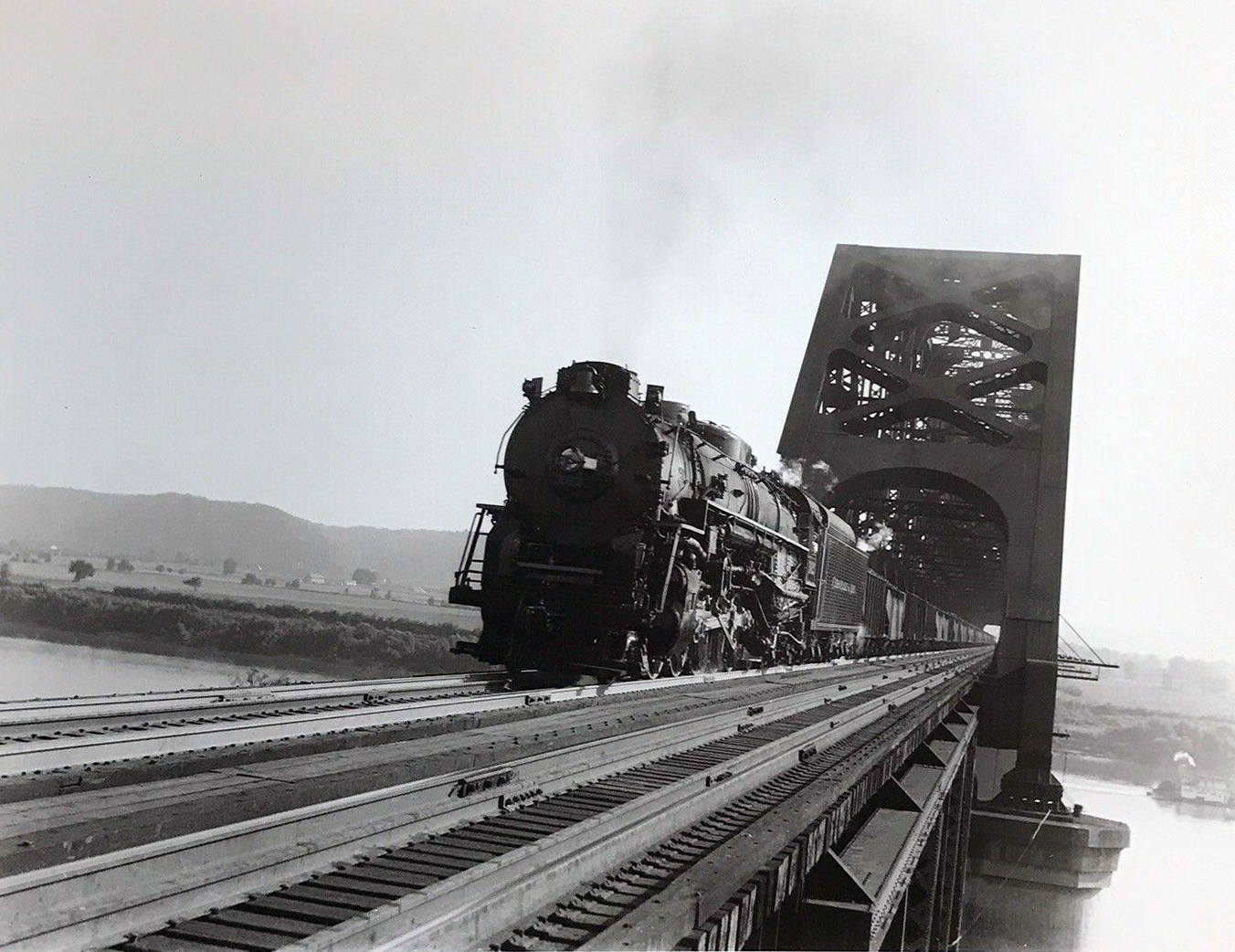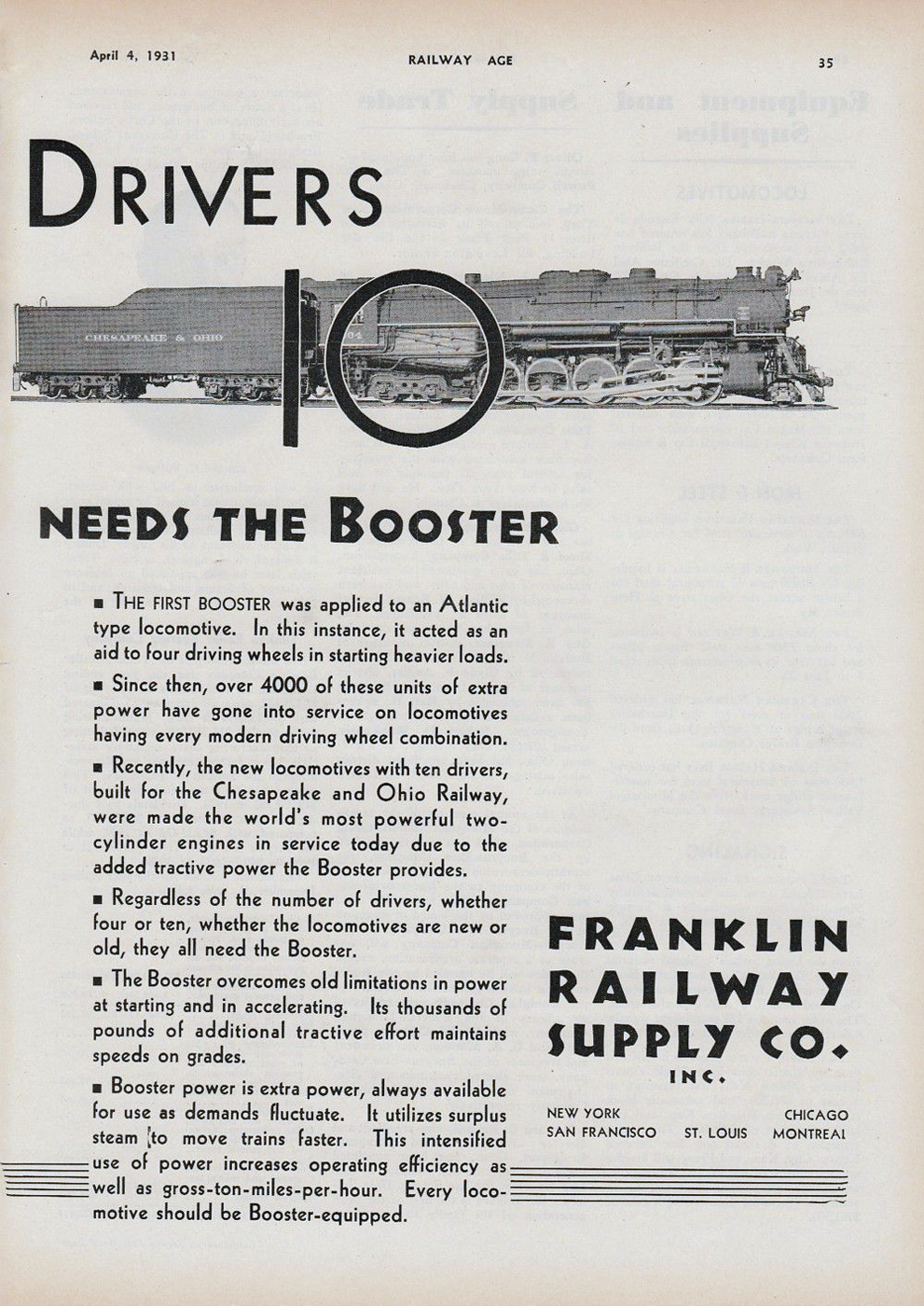C&O 2-10-4 Locomotives (Class T-1)
Last revised: February 2, 2024
By: Adam Burns
Chesapeake & Ohio's of T-1's included a fleet of forty 2-10-4 "Texas" types, which entered service just after the country entered the Great Depression. The success of these locomotives in heavy freight service sold the C&O on "Super Power" steam technology.
What was essentially an enlarged Berkshire, the 2-10-4's could handle well over 100-car trains in the rugged western territory with an ability to cruise at-speed.
Following the arrival of these engines virtually all future steam locomotives the railroad purchased were of the "Super Power" variety including such wheel arrangements as the 4-6-4, 4-8-4 Greenbriers, and of course the 2-8-4 Kanawhas. Sadly, no examples of these historic locomotives are preserved.
Photos
 In this Chesapeake & Ohio publicity photo 2-10-4 #3023 (T-1) has just left the Chicago main line as it hustles westbound/northbound across the Sciotoville Bridge spanning the mighty Ohio River with loads of coal destined for Columbus and Toledo in 1943.
In this Chesapeake & Ohio publicity photo 2-10-4 #3023 (T-1) has just left the Chicago main line as it hustles westbound/northbound across the Sciotoville Bridge spanning the mighty Ohio River with loads of coal destined for Columbus and Toledo in 1943.Super Power Steam
The C&O used a wide variety of wheel arrangements, from the massive 2-6-6-6 "Allegheny" to the small 2-8-0. These locomotives could be found in service until the end of steam.
In fact, as Tom Dixon notes in "Chesapeake and Ohio Railway: A Concise History and Fact Book," Chessie is said to have had more wheel arrangements in service (18) at the same time than any other railroad except the Santa Fe.
The C&O also employed big steam for fast freight operations, such as the 2-8-4 and the 2-10-4. These locomotive could high-step their way at over 30 mph lugging either heavy coal drags or merchandise trains.
The Texas Types introduced the Chesapeake & Ohio to the age of "Super Power" steam and was the first which its Advisory Mechanical Committee (AMC) took credit in designing. The AMC was an oversight body formed shortly after the Van Sweringen brothers gained control of the C&O in 1923.
Its purpose was to improve and standardize, among other initiatives, motive power across the Van Sweringen-owned properties, which at that time included the C&O, Erie, Nickel Plate, Pere Marquette and Hocking Valley Railway.
As Mr. Dixon points out the AMC, in addition to its research and development department, also held authority over mechanical decisions for each railroad.
The 2-10-4 was spawned from AMC's original interest in Super Power technology. This term chronicles late era steam locomotives which featured large, expanded fireboxes (requiring two trailing axles) that could produce near infinite quantities of steam.
Development
The C&O's 2-10-4's were born from the 2-8-4 Berkshire (or "Kanawhas" on the Chessie), the original Super Power design. This wheel arrangement had first been tested on New York Central's Boston & Albany subsidiary in northwestern Massachusetts during the spring of 1925.
Specifications
It appears the Van Sweringens' quickly recognized the inherent advantages of the 2-8-4 and were immediately impressed with Lima's "Super Power" concept. As Mr. Dixon notes only a few years later, in 1929, the brothers had formed the Advisory Mechanical Committee.
Over the next two decades the AMC refined a range of powerful new locomotives, perhaps the best remembered of which were the so-called 2-8-4 "Van Sweringen Berkshires" found on all of their railroads. The C&O's 2-10-4's rolled out within a year of the committee's formation, working with Lima in doing so.
In creating the T-1's, AMC and Lima based the design from Erie's successful Class S 2-8-4's, essentially stretching the locomotive by including an additional driving axle.
Per the AMC's recommendations the C&O ordered 40 2-10-4's from Lima in 1930, numbered 3000-3039. Not only were these locomotives powerful - able to exert tractive efforts of nearly 94,000 pounds - but with 69-inch drivers could lead a train of empty coal hoppers at 50 mph.
Advertisement
Both the railroad and its employees were very impressed with the 2-10-4's. As C&O historian Eugene L. Huddleston notes, "This was truly one of the greatest locomotives ever built." Mr. Dixon points out that the T-1's were the largest and most powerful non-articulated locomotives ever manufactured when they first entered service in 1930.
The C&O normally assigned them west of the Ohio River where they generally operated between Russell, Kentucky and Toledo, Ohio via Columbus. The engines could regularly handle 14,000-ton, 160-car coal drags to the Lake Erie docks and other points across Ohio.
Sometimes they would also venture east but this was relatively rare. The T-1's operated without major changes or upgrades throughout most of their careers although they did see an increase in boiler pressure to 265 psi, which slightly increased tractive effort.
Retirement
The locomotives were not particularly old by steam standards when their retirement came in 1952-1953. As a major shipper of coal the C&O was a staunch proponent of steam power, so much so that it continued acquiring new locomotives through the late 1940s.
It also took the bold step of testing experimental steam-turbine technology, which ultimately proved unsuccessful. As the secondary steam market faded away the C&O realized diesels were the future and began retiring steam by the mid-1950s. While the company preserved many examples of various wheel arrangements none of the 2-10-4's were saved.
Sources
- Dixon, Thomas W. Chesapeake And Ohio Railway: A Concise History And Fact Book. Clifton Forge: Chesapeake & Ohio Historical Society, 2012.
- Dixon, Thomas W. Chesapeake & Ohio Passenger Service: 1847-1971. Clifton Forge: Chesapeake & Ohio Historical Society, 2013.
- Morrison, Tom. American Steam Locomotive In The Twentieth Century. Jefferson: McFarland & Company, Inc., 2019.
- Simpson, Walter. Steam Locomotive Energy Story, The. New York: American University Presses, 2021.
SteamLocomotive.com
Wes Barris's SteamLocomotive.com is simply the best web resource on the study of steam locomotives.
It is difficult to truly articulate just how much material can be found at this website.
It is quite staggering and a must visit!

